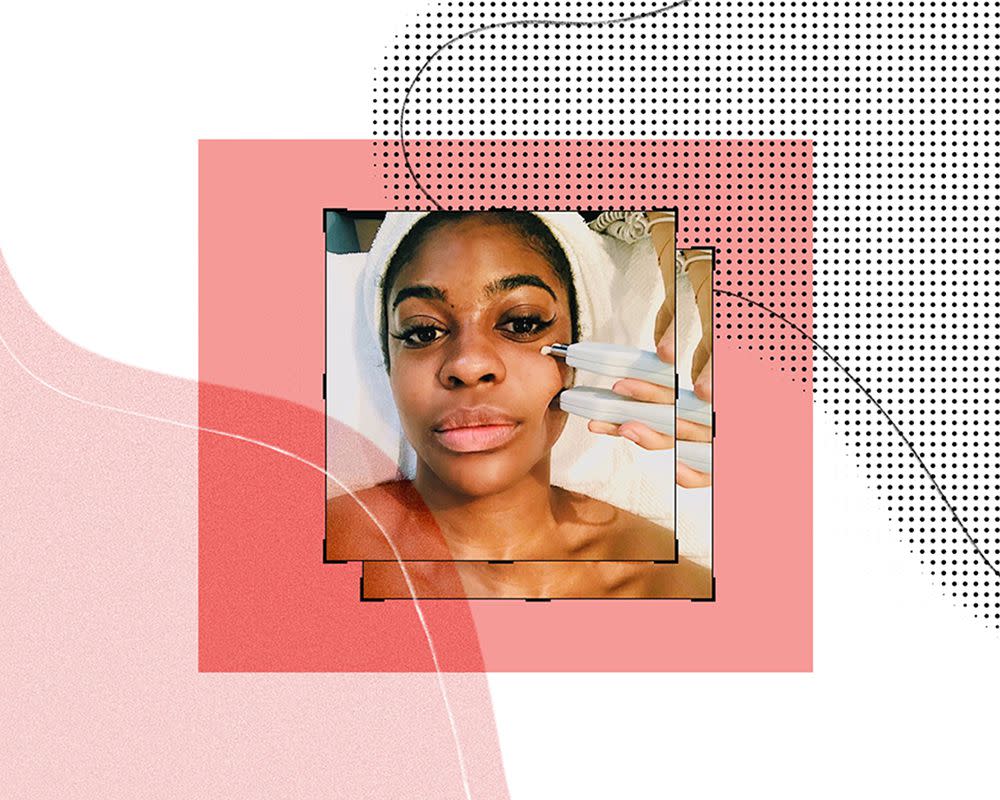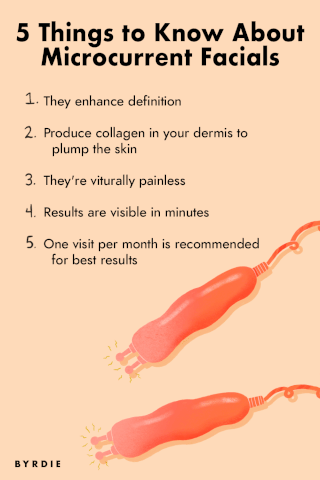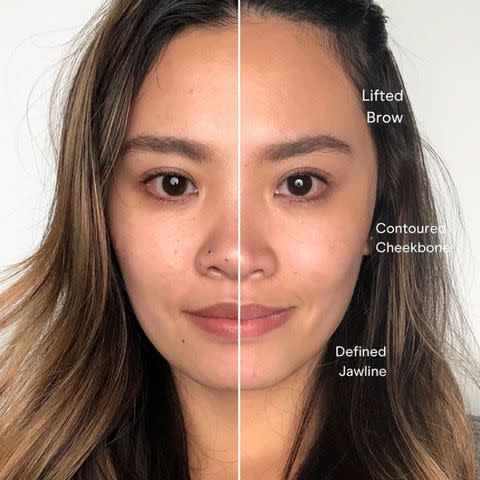I Got a Microcurrent Facial and It Sculpted My Jawline—Here's What You Need to Know

Maya Allen / Design by Dion Mills
- Oops!Something went wrong.Please try again later.
As a beauty editor with over 10 years in the industry, I'll try practically any beauty treatment once. So when I first heard about microcurrent facials—a painless, non-invasive procedure that promises to lift the skin in under an hour—I knew I needed to book an appointment. As I learned in my pre-appointment research, microcurrent facials are a type of aesthetic treatment that use low-voltage electricity to stimulate the facial muscles, mimicking a "workout" that lifts and tones the face. So—does it actually deliver on the claims? Ahead, I've tapped board-certified dermatologist Nava Greenfield and celebrity esthetician Joanna Vargas to cover everything you need to know about microcurrent facials, from the benefits to the cost, and more.
Joanna Vargas is a celebrity facialist whose client roster includes Mindy Kaling, Jenna Dewan, and Julianne Moore. She has two salons (NYC and L.A.) and is the creator of her eponymous skincare line.
Nava Greenfield, MD, is a board-certified dermatologist at Schweiger Dermatology Group in New York City.
What Is a Microcurrent Facial?
A microcurrent facial uses low-voltage electricity to stimulate the facial muscles, creating a lifting, toning effect on the skin. The treatment is painless and can create short-term and long-term results.
Benefits of Microcurrent Facials
Creates a lifted, sculpted appearance
Produces collagen in the dermis
Painless
Non-invasive
Zero downtime
Immediate results are visible in minutes; long-term use can also prevent sagging in the future

Madelyn Goodnight/Byrdie
How to Prepare for a Microcurrent Facial
Prep for a microcurrent facial is minimal—to speed up preparation in office, arrive with clean skin and don't wear any jewelry. "Eat a normal meal and take your normal medications before the procedure," explains Greenfield. "Don’t wear makeup and clean your face using a gentle wash. You may want to stop your retinol/retinoid five to seven days prior."
What to Expect During a Microcurrent Facial
I received my microcurrent facial as part of the Triple Crown facial treatment at Joanna Vargas Salon in NYC; so this was my experience: First, your esthetician or dermatologist slathers your face with conductive gel (it feels cooling and delightful), which will conduct the current from the microcurrent device.
Then, they'll run the microcurrent device over your skin in sweeping, upward, repetitive motions, typically treating these targeted areas: the jawline, the brows, the under-eyes, and the cheekbones. In each treatment area, your provider will slowly glide the handheld microcurrent device along your skin in an upward motion (towards the hairline) anywhere from 3-10 times. For areas like the brows where you may want an extra lift, they may hold the device in one position rather than glide it upward.
While the device is in action, your facial muscles will gently contract, but you won't experience any pain or cramping. At worst, you may notice a twitch here or there. The actual microcurrent part of the treatment typically lasts about 10-20 minutes—but your esthetician will likely finish your facial with a nice facial massage, cleaning off the conductive gel, and targeting any other skincare concerns you may have.
Before and After Results

[Note: This is a before-and-after photo provided by NuFACE and is not of the author].
After my treatment, it was like my skin had experienced the equivalent of a trampoline effect: It was bouncy, supple, and flexible. I'm 25 and take pride in the fact that I have no visible signs of fine lines or wrinkles yet—knock on wood—but I had a noticeably lifted appearance.
"The fun part about microcurrent is that you do see a result within minutes," says Vargas. "It's amazing when I can show a client one side of their face done and the other side undone." When I looked in the mirror immediately after treatment, my reflection revealed a slightly slimmer face with a more defined and sculpted bone structure. The microcurrent prongs definitely lifted my face, but they also reduced puffiness by working as a lymphatic drainage tool (think: a supercharged gua sha).
And while I loved my immediate results, keep in mind that the short term-results are only temporary; you'll need to repeat your treatment every four to six weeks to maintain your results. And as for the long-term results like collagen-boosting, you'll need to have patience. "I would caution that when something claims to promote collagen development and also that you should see immediate results—it’s almost an oxymoron—because collagen takes time for cells to build and release, it cannot happen immediately when you get up from the chair after the facial," Greenfield says.
Microcurrent vs. Microinfusion
While microcurrent focuses on the facial muscles, microinfusion is a treatment that injects a blend of skincare ingredients into the superficial layer of the skin. Microinfusion is also meant to stimulate collagen production, but its purpose is to improve skin's appearance at a micro-level. It promises to provide a glow and filler-like result, compared to something more face-lift-esque as you get with microcurrent.
At-Home vs. In-Office Microcurrent
"Different devices will provide different amounts of electrical current," explains Greenfield. At-home microcurrent devices, like the infamous NuFACE Trinity ($339), typically won't deliver as powerful of a current as in-office. Still, they're also more cost-friendly and can be used daily. You can expect more immediate, dramatic results when treating yourself to a professional facial because of the more intense electric pulsations—aka a more challenging face workout.
Potential Side Effects
Microcurrent generally should only feel like the pulsating contraction of your muscles—with a potential of a little buzzy, zing (nothing painful) here and there. However, Greenfield cautions that if your skin happens to be sensitive to the type of machine, "the experience can be an unpleasant one." Microcurrent is also not recommended for people who are pregnant or who have a pacemaker.
The Cost
A professional microcurrent facial will run you between $200-$500, depending on where you live and the length of the treatment. (Comparatively, an at-home device like the NuFace is around $335 and can be used for years to come).
Aftercare
Be gentle with your skin after the treatment. "Avoid any harsh rubbing or physically irritating it," Greenfield says. "Use only mild products and a lot of hydrating serums and moisturizers." It's also recommended to finish with a chemical-free sunscreen all over the face and neck.
For home treatments, be sure to properly clean your microcurrent device. Buildup on the conductive spheres can make it more difficult for the microcurrent to travel to your muscles. NuFACE suggests gently wiping the spheres down with a dampened washcloth after each treatment.
The Final Takeaway
As a millennial who loves instant gratification, I've found myself dreaming of my face's future after a couple more sessions. I see a more sculpted and defined jawline on my skin's horizon. Microcurrent facials can be thought of as taking your face to the gym, and I need to keep working out to see even more results. Vargas recommends clients indulge in these at least once a month. So now that you're abreast of everything there is to know about microcurrent facials, I recommend you book an appointment ASAP.
So will I consistently be indulging in this treatment to maintain my glow of youth? Absolutely.

